The First Time I Visited the Art Institute of Chicago
 | |
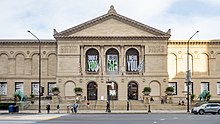 As seen from Michigan Ave | |
| Location within Chicago metropolitan area Show map of Chicago metropolitan surface area Fine art Establish of Chicago (Illinois) Show map of Illinois Art Institute of Chicago (the United States) Bear witness map of the U.s. | |
| Established | 1879; in nowadays location since 1893 |
|---|---|
| Location | 111 South Michigan Avenue Chicago, Illinois 60603 United states of america |
| Coordinates | 41°52′46″Due north 87°37′26″Westward / 41.87944°Northward 87.62389°W / 41.87944; -87.62389 Coordinates: 41°52′46″Due north 87°37′26″W / 41.87944°North 87.62389°W / 41.87944; -87.62389 |
| Collection size | 300,000 works |
| Visitors | ane.79 meg (2016)[1] 365,660 (2020) (drop due to COVID-19 pandemic closures)[2] |
| Director | James Rondeau |
| Public transit admission | CTA Coach routes: (half dozen and 28 line) 'L' and Subway stations: Adams-Wabash: Brownish Line Green Line Orange Line Pink Line Majestic Line Monroe/Country: Red Line Monroe/Dearborn: Blue Line Metra Train: Van Buren Street Station |
| Website | www.artic.edu |
The Art Institute of Chicago in Chicago's Grant Park, founded in 1879, is one of the oldest and largest art museums in the earth. Recognized for its curatorial efforts and popularity among visitors, the museum hosts approximately 1.5 million people annually.[three] Its collection, stewarded by eleven curatorial departments, is encyclopedic, and includes iconic works such every bit Georges Seurat's A Sun on La Grande Jatte, Pablo Picasso's The Quondam Guitarist, Edward Hopper's Nighthawks, and Grant Wood's American Gothic. Its permanent collection of nearly 300,000 works of art is augmented by more than than thirty special exhibitions mounted yearly that illuminate aspects of the collection and present cutting-edge curatorial and scientific research.
As a inquiry institution, the Art Institute also has a conservation and conservation science section, 5 conservation laboratories, and one of the largest fine art history and architecture libraries in the country—the Ryerson and Burnham Libraries.
The growth of the collection has warranted several additions to the museum's 1893 building, which was constructed for the Globe's Columbian Exposition. The virtually recent expansion, the Modern Wing designed by Renzo Piano, opened in 2009 and increased the museum's footprint to nearly one 1000000 foursquare anxiety, making it the second-largest art museum in the United states of america, after the Metropolitan Museum of Art.[4] The Art Constitute is associated with the School of the Fine art Establish of Chicago, a leading fine art schoolhouse, making information technology one of the few remaining unified arts institutions in the United States.
In 2017, the Art Constitute received 1,619,316 visitors, and was the 35th most-visited art museum in the earth.[five] Nevertheless, in 2020, due to the COVID-xix pandemic, the museum was closed for 169 days, and attendance plunged by 78 percent from 2019, to 365,660.[6]
History [edit]
In 1866, a group of 35 artists founded the Chicago Academy of Design in a studio on Dearborn Street, with the intent to run a free school with its own art gallery. The organization was modeled after European fine art academies, such every bit the Imperial University, with Academicians and Associate Academicians. The Academy'south charter was granted in March 1867.
Classes started in 1868, meeting every 24-hour interval at a toll of $10 per month. The Academy'southward success enabled it to build a new home for the school, a five-story rock edifice on 66 West Adams Street, which opened on Nov 22, 1870.
When the Great Chicago Burn down destroyed the edifice in 1871 the Academy was thrown into debt. Attempts to continue despite the loss past using rented facilities failed. By 1878, the Academy was $10,000 in debt. Members tried to rescue the ailing institution by making deals with local businessmen, earlier some finally abandoned it in 1879 to found a new organisation, named the Chicago Academy of Fine Arts. When the Chicago University of Design went bankrupt the same year, the new Chicago University of Fine Arts bought its avails at sale.

This 1893 sketch of the then new Art Institute of Chicago shows most of today'south Grant Park yet submerged nether Lake Michigan, with the railroad tracks running along the shoreline behind the Museum
In 1882, the Chicago Academy of Fine Arts changed its name to the current Fine art Plant of Chicago and elected as its first president the banker and philanthropist Charles Fifty. Hutchinson, who "is arguably the unmarried most of import individual to have shaped the direction and fortunes of the Art Establish of Chicago".[vii] : 5 Hutchinson was a director of many prominent Chicago organizations, including the Academy of Chicago,[8] and would transform the Art Institute into a world-class museum during his presidency, which he held until his death in 1924.[9] Also in 1882, the organisation purchased a lot on the southwest corner of Michigan Avenue and Van Buren Street for $45,000. The existing commercial building on that property was used for the organization's headquarters, and a new addition was synthetic backside it to provide gallery space and to house the school's facilities.[7] : 19 By January 1885 the trustees recognized the need to provide additional space for the organization's growing collection, and to this terminate purchased the vacant lot straight due south on Michigan Avenue. The commercial building was demolished,[10] and the noted architect John Wellborn Root was hired by Hutchinson to blueprint a edifice that would create an "impressive presence" on Michigan Avenue,[7] : 22–23 and these facilities opened to dandy fanfare in 1887.[7] : 24
With the annunciation of the Globe's Columbian Exposition to be held in 1892–93, the Art Institute pressed for a building on the lakefront to exist constructed for the fair, simply to exist used by the Institute afterwards. The metropolis agreed, and the building was completed in time for the 2d twelvemonth of the fair. Construction costs were met by selling the Michigan/Van Buren property. On Oct 31, 1893, the Institute moved into the new building. For the opening reception on December eight, 1893, Theodore Thomas and the Chicago Symphony Orchestra performed.
From the early on 1900s (to the 1960s the school offered with the Logan Family (members of the board) the Logan Medal of the Arts, an award which became one of the almost distinguished awards presented to artists in the US. Between 1959 and 1970, the institute was a key site in the boxing to proceeds art and documentary photography a identify in galleries, under curator Hugh Edwards and his administration.
As Director of the museum starting in the early 1980s, James N. Woods conducted a major expansion of its collection and oversaw a major renovation and expansion project for its facilities. As "one of the most respected museum leaders in the country", every bit described past The New York Times, Wood created major exhibitions of works past Paul Gauguin, Claude Monet and Vincent van Gogh that set records for omnipresence at the museum. He retired from the museum in 2004.[11]
The Constitute began construction of "The Mod Wing", an addition situated on the southwest corner of Columbus and Monroe in the early 21st century.[12] The projection, designed past Pritzker Prize–winning architect Renzo Piano, was completed and officially opened to the public on May 16, 2009. The 264,000-square-foot (24,500 yard2) building addition made the Art Institute the second-largest fine art museum in the U.s.a.. The building houses the museum's world-renowned collections of 20th and 21st century fine art, specifically modernistic European painting and sculpture, contemporary art, architecture and design, and photography. In its inaugural survey in 2014, travel review website and forum, Tripadvisor, reviewed millions of travelers' surveys and named the Art Institute the world's best museum.[13]
The museum received mayhap the largest gift of fine art in its history in 2015.[14] Collectors Stefan Edlis and Gael Neeson donated a "drove [that] is amid the globe's greatest groups of postwar Pop fine art always assembled".[15] The donation includes works by Andy Warhol, Jasper Johns, Cy Twombly, Jeff Koons, Charles Ray, Richard Prince, Cindy Sherman, Roy Lichtenstein and Gerhard Richter. The museum agreed to keep the donated work on display for at least fifty years.[15] In June 2018, the museum received a $50 million donation, the largest single appear monetary donation in its history.[16]
Collection [edit]
The collection of the Art Constitute of Chicago encompasses more than 5,000 years of human being expression from cultures around the earth and contains more than 300,000 works of art in eleven curatorial departments, ranging from early Japanese prints to the fine art of the Byzantine Empire to contemporary American fine art. It is principally known for one of the U.s.' finest drove of paintings produced in Western culture.[17] [18]
African Fine art and Indian Art of the Americas [edit]
The Art Institute's African Art and Indian Fine art of the Americas collections are on display across two galleries in the south terminate of the Michigan Avenue edifice. The African drove includes more than 400 works that span the continent, highlighting ceramics, garments, masks, and jewelry.[xix]
The Amerindian drove includes Native Due north American art and Mesoamerican and Andean works. From pottery to textiles, the collection brings together a wide array of objects that seek to illustrate the thematic and aesthetic focuses of art spanning the Americas.[xx]
American Fine art [edit]
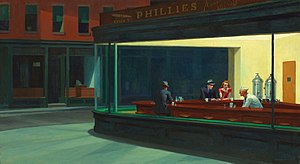

The Art Institute's American Art collection contains some of the best-known works in the American canon, including Edward Hopper'south Nighthawks, Grant Wood's American Gothic, and Mary Cassatt'southward The Child'due south Bath. The collection ranges from colonial silver to modern and contemporary paintings.
The museum purchased Nighthawks in 1942 for $3,000;[21] [22] [23] its acquisition "launched" the painting into "immense popular recognition".[24] Considered an "icon of American culture",[21] [25] Nighthawks is perhaps Hopper's most famous painting, besides equally 1 of the virtually recognizable images in American art.[26] [27] [28] Also well known, American Gothic has been in the museum'southward collection since 1930 and was simply loaned outside of North America for the first time in 2016.[29] Wood's painting depicts what has been called "the most famous couple in the world", a dour, rural-American, begetter and daughter. Information technology was entered into a contest at the Art Establish in 1930, and although not a favorite of some, it won a medal and was acquired by the museum.[30] [31]
Aboriginal and Byzantine [edit]
The Art Establish's ancient collection spans almost 4,000 years of fine art and history, showcasing Greek, Etruscan, Roman, and Egyptian sculpture, mosaics, pottery, jewelry, glass, and bronze every bit well as a robust and well-maintained collection of ancient coins. There are around 5,000 works in the collection, offering a comprehensive survey of the ancient and medieval Mediterranean world, beginning with the tertiary millennium B.C. and extending to the Byzantine Empire.[32] The collection besides holds the mummy and mummy case of Paankhenamun.[33] [34]
Architecture and Design [edit]
The Department of Architecture and Design holds more than 140,000 works, from models to drawings from the 1870s to the nowadays day. The collection covers landscape architecture, structural engineering, and industrial design, including the works of Frank Lloyd Wright, Ludwig Mies van der Rohe, and Le Corbusier.[35]
Asian Fine art [edit]
The Fine art Institute's Asian collection spans nearly 5,000 years, including significant works and objects from China, Korea, Japan, India, Southeast Asia, and the Near and Centre East. There are 35,000 objects in the collection, showcasing bronzes, ceramics, and jades as well equally textiles, screens, woodcuts, and sculptures.[36] 1 gallery in particular attempts to mimic the serenity and meditative manner in which Japanese screens are traditionally viewed.
European Decorative Arts [edit]

The Art Institute's collection of European decorative arts includes some 25,000 objects of furniture, ceramics, metalwork, glass, enamel, and ivory from 1100 A.D. to the nowadays day. The department contains the 1,544 objects in the Arthur Rubloff Paperweight Collection and the 68 Thorne Miniature Rooms–a collection of miniaturized interiors of a 1:12 scale showcasing American, European, and Asian architectural and furniture styles from the Middle Ages to the 1930s (when the rooms were synthetic).[37] Both the paperweights and the Thorne Rooms are located on the footing floor of the museum.
European Painting and Sculpture [edit]

The museum is most famous for its collections of Impressionist and Post-Impressionist paintings, widely regarded as 1 of the finest collections exterior of France.[38] Highlights include more than 30 paintings by Claude Monet, including half-dozen of his Haystacks and a number of H2o Lilies. Also in the collection are of import works by Pierre-Auguste Renoir such as Two Sisters (On the Terrace), and Gustave Caillebotte'south Paris Street; Rainy Day. Post-Impressionist works include Paul Cézanne's The Basket of Apples, and Madame Cézanne in a Yellowish Chair. At the Moulin Rouge by Henri de Toulouse-Lautrec is another highlight. The pointillist masterpiece, which likewise inspired a musical and was famously featured in Ferris Bueller's Twenty-four hour period Off, Georges Seurat'due south Sunday Afternoon on La Grande Jatte—1884, is prominently displayed. Additionally, Henri Matisse's Bathers past a River, is an important example of his work. Highlights of non-French paintings of the Impressionist and Post-Impressionist collection include Vincent van Gogh's Bedroom in Arles and Self-portrait, 1887.
In the mid-1930s, the Art Found received a gift of over 1 hundred works of art from Annie Swan Coburn ("Mr. and Mrs. Lewis Larned Coburn Memorial Collection"). The "Coburn Renoirs" became the core of the Art Establish'south Impressionist painting collection.[39]
The collection likewise includes the Medieval and Renaissance Art, Artillery, and Armor holdings, including the George F. Harding Collection of arms and armor,[twoscore] and three centuries of Old Masters works.[41]
Modern and Contemporary Art [edit]
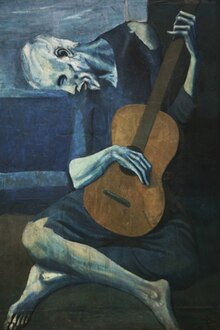
The museum's collection of modern and contemporary art was significantly augmented when collectors Stefan Edlis and Gael Neeson gifted 40 plus master works to the department in 2015.[42] Pablo Picasso's Old Guitarist, Henri Matisse's Bathers past a River, Constantin Brâncuși's Aureate Bird, and René Magritte's Time Transfixed are highlights of the modernistic galleries, located on the third flooring of the Modern Wing.[43] The gimmicky installation, located on the 2d floor, contains works by Andy Warhol, Cindy Sherman, Cy Twombly, Jackson Pollock, Jasper Johns, and other significant modernistic and contemporary artists.
Photography [edit]
The Art Institute didn't officially institute a photography collection until 1949, when Georgia O'Keeffe donated a pregnant portion of the Alfred Stieglitz drove to the museum.[44] Since then, the museum's collection has grown to approximately xx,000 works spanning the history of the artform from its inception in 1839 to the present.
Prints and Drawings [edit]
The print and drawings drove began with a donation by Elizabeth S. Stickney of 460 works in 1887, and was organized into its own department of the museum in 1911.[45] Their holdings have after grown to 11,500 drawings and sixty,000 prints, ranging from 15th-century works to contemporary. The collection contains a strong grouping of the works of Albrecht Dürer, Rembrandt van Rijn, Francisco Goya, and James McNeill Whistler. Because works on paper are sensitive to light and degrade quickly, the works are on display infrequently in gild to proceed them in practiced condition for every bit long as possible.
Textiles [edit]
The Department of Textiles has more than than thirteen,000 textiles and 66,000 sample swatches in full, covering an array of cultures from 300 B.C. to the nowadays. From English needlework to Japanese garments to American quilts, the collection presents a various group of objects, including contemporary works and fiber art.[46]
Architecture [edit]

Michigan Artery entrance today
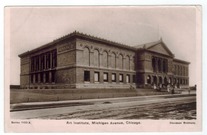
A postcard of the Art Institute dated 1907
The current building at 111 Due south Michigan Avenue is the third address for the Art Institute. Information technology was designed in the Beaux-Arts style past Shepley, Rutan and Coolidge of Boston[47] for the 1893 World's Columbian Exposition as the Globe'south Congress Auxiliary Building with the intent that the Art Institute occupy the infinite later on the fair closed.
The Fine art Institute's famous western entrance on Michigan Artery is guarded past two statuary king of beasts statues created by Edward Kemeys. The lions were unveiled on May 10, 1894, each weighing more than two tons. The sculptor gave them unofficial names: the south lion is "stands in an attitude of disobedience", and the northward lion is "on the cruise". When a Chicago sports team plays in the championships of their corresponding league (i.e. the Super Basin or Stanley Loving cup Finals, not the entire playoffs), the lions are frequently dressed in that team's uniform. Evergreen wreaths are placed around their necks during the Christmas flavor.
The east archway of the museum is marked by the stone curvation entrance to the old Chicago Stock Exchange. Designed past Louis Sullivan in 1894, the Exchange was torn down in 1972, but salvaged portions of the original trading room were brought to the Art Institute and reconstructed.
The Art Institute edifice has the unusual holding of straddling open-air railroad tracks. 2 stories of gallery space connect the east and west buildings while the Metra Electric and Due south Shore lines operate beneath. The lower level of gallery infinite was formerly the windowless Gunsaulus hall, but is now habitation to the Alsdorf Galleries showcasing Indian, Southeast Asian and Himalayan Art. During renovation, windows facing due north toward Millennium Park were added. The gallery infinite was designed by Renzo Piano in conjunction with his design of the Modern Wing and features the aforementioned window screening used there to protect the art from straight sunlight. The upper level formerly held the modern European galleries, but was renovated in 2008 and now features the Impressionist and Post-Impressionist galleries.
Libraries [edit]

Located on the ground floor of the museum is the Ryerson & Burnham Libraries. The Libraries' collections comprehend all periods of fine art, but is most known for its extensive collection of 18th to 20th century architecture. Information technology serves the museum staff, higher and university students, and is too open to the general public. The Friends of the Libraries, a support group for the Libraries, offers events and special tours for its members.
Modernistic Fly [edit]
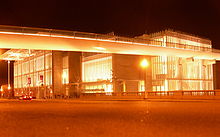
Art Institute of Chicago Modern Wing
On May 16, 2009, the Art Institute opened the Modern Wing, the largest expansion in the museum's history.[48] The 264,000-square-foot (24,500 m2) addition, designed by Renzo Piano, makes the Fine art Institute the second-largest museum in the US.[iv] The architect of tape in the City of Chicago for this building was Interactive Design.[49] The Modern Fly is abode to the museum's collection of early on 20th-century European art, including Pablo Picasso's The Old Guitarist, Henri Matisse's Bathers by a River, and René Magritte'southward Time Transfixed. The Lindy and Edwin Bergman Collection of Surrealist art includes the largest public brandish of Joseph Cornell's works (37 boxes and collages).[50] The Wing also houses contemporary art from afterwards 1960; new photography, video media, compages and design galleries including original renderings past Frank Lloyd Wright, Ludwig Mies van der Rohe and Bruce Goff; temporary exhibition space; shops and classrooms; a cafe and a restaurant, Terzo Piano, that overlooks Millennium Park from its terrace.[51] In addition, the Nichols Bridgeway connects a sculpture garden on the roof of the new wing with the next Millennium Park to the north and a courtyard designed by Gustafson Guthrie Nichol. In 2009, the Modern Wing won at the Chicago Innovation Awards.[52]
Selections from the permanent collection [edit]
Notation that other notable works are in the collection but the post-obit examples are ones in the public domain and for which pictures are available. In 2018, as it redesigned its website, the Fine art Establish released 52,438 of its public domain works, nether the Creative Eatables Nil (CC0) licence.[53]
Paintings [edit]
-

-
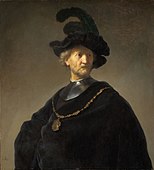
-

-

-

-
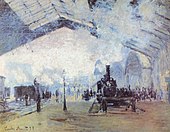
-

-
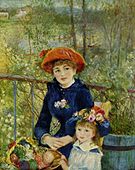
-

Paul Cézanne, The Bay of Marseilles, view from L'Estaque, 1885
-

-

-
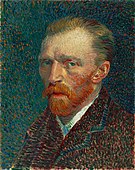
-
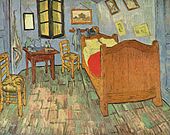
-
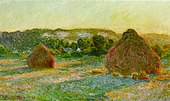
-

-
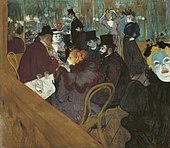
-
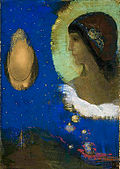
-

Pablo Picasso, 1904, Woman with a Helmet of Hair, gouache on tan wood pulp board
-

-

-

Kazimir Malevich, Painterly Realism of a Football Histrion—Color Masses in the quaternary Dimension, 1915
-

-

Sculptures [edit]
More highlights from the drove [edit]
-

One of the Thorne Miniature Rooms, c. 1930s
-

Pieces from the porcelain collection in the Art Establish of Chicago
-

Museum hall
Governance [edit]
Attendance [edit]
During 2009, omnipresence was around ii million—up 33 percent from 2008—in addition to a total of approximately 100,000 museum memberships. Despite a 25 percentage boost in museum access fees, the Modern Wing was a major goad for a rising in visitor traffic.[54]
Finances [edit]
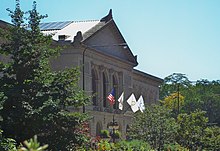
Every bit of 2011, the Art Institute continues to rebuild its $783 million endowment since the recession.[55] In June 2008, its endowment was $827 million. As of 2012, the museum is rated A1 by Moody's, its fifth-highest class, in role reflecting the museum's pension and retirement liabilities; Standard & Poor's rates the museum A+, fifth-best. In October 2012, the Fine art Plant sold about $100 million of taxable and revenue enhancement-exempt bonds partly to shore up unfunded pension obligations.[56]
The $294 1000000 extension in 2009 was the culmination of a $385 million fundraising campaign—roughly $300 million for design and structure and $85 1000000 for the endowment. Around $370 million were raised primarily from individual patrons in Chicago.[57] In 2011, the Fine art Institute received a $10 one thousand thousand gift from the Jaharis Family Foundation to renovate and expand galleries devoted to Greek, Roman and Byzantine fine art, every bit well as to support acquisitions and special exhibitions of that art.[58]
Acquisitions and deaccessioning [edit]
In 1990, the Art Institute of Chicago sold xi works at auction, including paintings by Claude Monet, Pablo Picasso, Amedeo Modigliani, Maurice Utrillo and Edgar Degas, to raise the $12 million purchase price of a bronze sculpture, Gilded Bird, by Constantin Brâncuși. At the time, the sculpture was endemic by the Arts Guild of Chicago, which was selling information technology to buy a new gallery for its other works.[59] In 2005, the museum sold 2 paintings by Marc Chagall and Auguste Renoir at Sotheby'southward.[threescore] In 2011, it auctioned two Picassos (Sur l'impériale traversant la Seine (1901) and Verre et pipe (1919)), Henri Matisse'south Femme au fauteuil (1919), and Georges Braque's Nature morte à la guitare (rideaux rouge) (1938) at Christie's in London.[61] [62]
Directors [edit]
- William M.R. French (1885–1914)
- Newton Carpenter (1914–1916)
- George Eggers (1918–1921)
- Robert Harshe (1921–1938)
- Daniel Catton Rich (1938–1958)
- Allen McNab (1956–1965)
- Charles Cunningham (1965–1972)
- Eastward. Laurence Chalmers (1972–1986)
- James N. Woods (1980–2004)
- James Cuno (2004–2011)
- Douglas Druick (2011–2016)
- James Rondeau (2016–nowadays)
Controversy [edit]
Direction of investments dispute [edit]
In 2002, the Fine art Institute of Chicago filed adjust alleging fraud by a small Dallas business firm called Integral Investment Management, along with related parties. The museum, which put $43 million of its endowment into funds run by the defendants, claimed that it faced losses of up to 90% on the investments later they soured.[63]
Construction disputes [edit]
In 2010, the year after the opening of its massive Modernistic Wing, the Art Institute of Chicago sued the engineering science firm Ove Arup for $ten 1000000 over what it said were flaws in the concrete floors and air-apportionment systems. The adapt was settled out of courtroom.[64] [65]
Docent programme diversity dispute [edit]
In 2021, the Art Institute ended its unpaid volunteer docents program to move to a paid model. The Chicago Tribune editorial page criticized the Intitute's letter announcing the change and the motion to a new model, arguing that "[o]nce you cut through the blather, the letter basically said the museum had looked critically at its corps of docents, a group dominated by generally (but not entirely) white, retired women with some time to spare, and found them wanting every bit a demographic."[66] The Constitute's manager, Robert M. Levy, responded in a Tribune op-ed supporting the change, and described the Tribune'southward editorial equally having "numerous inaccuracies and mischaracterizations", noted that the docent program had already been largely on interruption for the past 15 months due to the COVID pandemic, and argued that the conclusion was not about anyone's identity, it was in keeping with changing modern museum practices around the world.[67]
Following a volunteerism surge in the late 1940s, the program had been created in 1961 to revitalize and expand "programming for children."[68] Among other matters, since 2014 the program had been trying to attract a more various socioeconomic perspective set of art-tour guides, given the unpaid time delivery needed.[69]
In popular culture [edit]
Director John Hughes included a sequence in the Fine art Institute in his 1986 film Ferris Bueller's 24-hour interval Off, which is set in Chicago. During it the characters are shown viewing A Sunday Afternoon on the Island of La Grande Jatte. Hughes had starting time visited the Institute as a "refuge" while in high schoolhouse. Hughes' commentary on the sequence was used as a reference indicate by journalist Hadley Freeman in a discussion of the Republican presidential primary candidates in 2011.[71]
The paintings used in the 1970 Parker Brothers board game Masterpiece are works held in the Art Found's collection.[72] [ non-primary source needed ]
See also [edit]
- American Academy of Art
- Bessie Bennett, early 20th century Curator of Decorative Fine art
- Forest Idyll
- List of nigh-visited museums in the United States
- Listing of museums and cultural institutions in Chicago
- Alme Meyvis
- Visual arts of Chicago
References [edit]
- ^ Johnson, Steve (January 25, 2017). "Chicago museums set attendance records in 2016". Chicago Tribune . Retrieved 2021-01-29 .
- ^ Fine art Paper List of Most-Visited Art museums, 31 March 2021
- ^ "Visitor Figures 2013: Museum and exhibition attendance numbers compiled and analysed" (PDF). The Fine art Newspaper (International ed.). XXIII (256). April 2014.
- ^ a b Smith, Roberta (May 13, 2009). "A Thou and Intimate Modern Art Trove". The New York Times . Retrieved 2011-06-xiii .
- ^ "Exhibition and Museum Visitor Figures 2017". The Art Newspaper. March 26, 2018. Retrieved 2021-10-11 .
- ^ Sharpe, Emily; da Silva, José (March 30, 2021). "Company Figures 2020: acme 100 art museums revealed as attendance drops past 77% worldwide". The Fine art Paper.
- ^ a b c d Hilliard, Celia (2010). "The Prime number Mover" - Charles L. Hutchinson and the making of the Art Institute of Chicago. Chicago: The Fine art Institute of Chicago. ISBN978-086559-238-4.
- ^ "Few Changes Made - Academy of Chicago Trustees Concord an Election - Ii Vacancies Filled - Other Members Whose Terms Expired Re-Elected - Examinations for Positions as Teachers in the Public Schools of the City". The Daily Inter-Ocean: ane. June 28, 1893.
- ^ Dillon, Diane (September 18, 2004). Art Found of Chicago. Encyclopedia of Chicago. The Newberry Library. Retrieved 2015-07-24 .
- ^ "The Art Plant – The Western Art Movement and its First-class Achievements in Chicago – The New Domicile of the Fine Arts – The Ward Collection – The Century, Harper's - The Formal Opening of the New Museum – The Loan Collection – A Noble Triumph". The (Chicago) Inter Bounding main. XVI (239): 9. November 20, 1887.
- ^ Kennedy, Randy (June 14, 2010). "James N. Wood, President of the Getty Trust, Dies at 69". The New York Times. Retrieved 2010-06-21.
- ^ Kamin, Blair (May 31, 2005). "Art Establish to Add New Fly". Chicago Tribune . Retrieved 2021-01-29 .
- ^ Grossman, Samantha (September xviii, 2014). "These Are the 25 Best Museums in the Globe". Time . Retrieved 2014-09-nineteen .
- ^ Johnson, Steve (April 22, 2015). "Art Institute of Chicago gets its largest gift ever, including nine Warhols". Chicago Tribune.
- ^ a b Chappell, Nib (Apr 22, 2015). "Gift Worth $400 Million To Fine art Plant Of Chicago Includes Works Past Warhol". WBEZ News.
- ^ Johnson, Steve (April 17, 2018). "Art Institute lands largest announced greenbacks donation, $lxx million in total". Chicago Tribune . Retrieved 2021-01-29 .
- ^ Chilvers, Ian, ed. (2004). The Oxford Dictionary of Art: The Fine art Institute of Chicago . Oxford Academy Printing. pp. 813–814. ISBN978-0-1928-0022-0.
Celebrated masterpieces: Nighthawks; American Gothic; A Sunday Afternoon on the Island of La Grande Jatte.
- ^ "World's most beautiful museums". Fox News. May 3, 2013. Retrieved 2013-05-04 .
Must-run into masterpieces: Georges Seurat's A Sunday on the Island of La Grande Jatte, Nighthawks, and Vincent Van Gogh's Bedchamber in Arles.
- ^ "Arts of Africa". Art Institute of Chicago . Retrieved 2019-08-10 .
- ^ "Arts of the Americas". Art Institute of Chicago . Retrieved 2016-08-03 .
- ^ a b "Nighthawks". Art Establish of Chicago.
- ^ The sale was recorded past Josephine Hopper as follows, in volume Ii, p. 95 of her and Edward'southward periodical of his fine art: "May 13, '42: Chicago Fine art Institute - 3,000 + render of Compartment C in exchange as part payment. 1,000 - 1/3 = 2,000." See Deborah Lyons, Edward Hopper: A Journal of His Work New York: Whitney Museum of American Art, 1997, p. 63.
- ^ "Art Institute of Chicago". visual-arts-cork.com.
- ^ Levin, Gail (1996). "Edward Hopper's Nighthawks, Surrealism, and the War". Art Institute of Chicago Museum Studies. 22 (2): 180–195 at 189, 193–194. doi:10.2307/4104321. JSTOR 4104321.
- ^ "Edward Hopper". A Closer Look. National Gallery of Art. 2006. Archived from the original on 2013-03-12. Retrieved 2013-04-xxx .
- ^ "Almost This Artwork: Nighthawks, 1942". Art Institute of Chicago . Retrieved 2013-05-04 .
- ^ Simon, Scott (2002-10-07). "Present at the Creation: Edward Hopper's Nighthawks". Morning Edition. NPR. Archived from the original on 2013-06-01. Retrieved 10 September 2018.
- ^ Woods, James Northward. (1996). The Art Plant of Chicago, 20th-Century: Painting and Sculpture. Hudson Hills. ISBN978-0-8655-9096-0.
- ^ "American Gothic". Art Institute of Chicago . Retrieved 2016-08-03 .
- ^ Fineman, Mia (June 8, 2005). "The Near Famous Farm Couple in the World: Why American Gothic all the same fascinates". Slate.
- ^ "Virtually This Artwork: American Gothic". Fine art Establish of Chicago. Archived from the original on 28 May 2010. Retrieved June twenty, 2010.
- ^ "Ancient and Byzantine". Art Constitute of Chicago . Retrieved 2016-08-03 .
- ^ "Coffin and Mummy Case of Paankhenamun" (PDF). The Fine art Institute of Chicago . Retrieved 2013-01-xiii .
- ^ "Coffin and Mummy of Paankhenamun". Art Institute of Chicago . Retrieved 2016-08-03 .
- ^ "Architecture and Design". Art Establish of Chicago . Retrieved 2016-08-03 .
- ^ "Asian Art". Art Found of Chicago . Retrieved 2016-08-03 .
- ^ "Thorne Miniature Rooms". Fine art Plant of Chicago. Archived from the original on June 15, 2011. Retrieved 2011-06-13 .
- ^ Galloway, Paul, and Alan One thousand. Artner (September 29, 1996). "City'due south Impressionist Trove Rooted in Firm of Palmer". Chicago Tribune. Retrieved 2019-x-28.
- ^ "Case viii: Annie Swan Coburn". Women of the Fine art Institute . Retrieved 2018-06-16 .
- ^ Karcheski, Jr., Walter J. (1995). "Essay: George F. Harding, Jr. and His "Castle"". Art Institute of Chicago . Retrieved January 29, 2021.
- ^ "Arms, Armor, Medieval, and Renaissance". Art Institute of Chicago. Archived from the original on 2016-07-31. Retrieved 2016-08-03 .
- ^ Johnson, Steve (December nine, 2015). "Massive art gift transforms Art Plant". Chicago Tribune . Retrieved 2016-08-03 .
- ^ "Modern Art". Art Institute of Chicago . Retrieved 2016-08-03 .
- ^ "Photography". Fine art Plant of Chicago . Retrieved 2016-08-03 .
- ^ Engelbrecht, Theresa Moir. "Inter-Collected: The Shared History of the Impress Society and Museum Collection," Art in Print. Vol. 7 No. two (July–August 2017), thirty.
- ^ "Textiles". Art Institute of Chicago . Retrieved 2016-08-03 .
- ^ "1879–1913: The Determinative Years". Art Found of Chicago. 2007. Archived from the original on June 9, 2007. Retrieved 2007-06-twenty .
- ^ Ourossof, Nicolai (May 13, 2009). "Renzo Pianoforte Embraces Chicago". The New York Times. Archived from the original on 2011-05-13. Retrieved 2011-06-13 .
- ^ "The Modern Wing At The Art Institute Of Chicago". Interactive Design Architects . Retrieved 2020-08-06 .
- ^ Seaman, Donna (March 23, 1997). "Joseph Cornell'southward Works At The Art Found". Chicago Tribune.
- ^ "A New Kind of Institutional Dining". Zagat. May 27, 2009. Archived from the original on May 5, 2019.
- ^ "2009 Chicago Innovation Honor winners". Chicago Innovation Awards. Archived from the original on 2010-03-11.
- ^ Neault, Michael (22 October 2018). "Behind the Scenes of the Website Redesign". Art Establish of Chicago . Retrieved 2018-11-29 .
- ^ Viera, Lauren (May 9, 2011). Art Institute leader resigns Chicago Tribune.
- ^ Crow, Kelly. (Baronial 24, 2011), "Chicago's Fine art Institute Names New Director". The Wall Street Journal.
- ^ Chappatta, Brian. (October 9, 2012). "Chicago Fine art Found Borrows $100 Million for Pensions". Bloomberg Businessweek.
- ^ Kaufman, Jason Edward. (May 13, 2009). "Art Institute of Chicago'due south massive extension opens". Archived October sixteen, 2012, at the Wayback Machine The Art Newspaper.
- ^ Taylor, Kate (February 27, 2011). "A Gift for Art Found". The New York Times.
- ^ Chicago Gallery to Sell 11 Works to Buy Brancusi Los Angeles Times. United Press International, May 10, 1990.
- ^ Vogel, Carol (October 26, 2005). "Museums Set to Sell Fine art, and Some Experts Cringe". The New York Times.
- ^ Viera, Lauren (January xi, 2011). "Art Plant paintings to fetch $ten-$16 million at sale". Chicago Tribune.
- ^ Pogrebin, Robin (January 26, 2011). "The Permanent Collection May Not Exist So Permanent". The New York Times.
- ^ "Stick to paintings". The Economist. 3 January 2002. Retrieved 2014-ten-24 .
- ^ Finkel, Jori (3 June 2014). "Eli Broad's Fine art Showcase, Still Unfinished, Sues Over Delays in Los Angeles". The New York Times.
- ^ Kapos, Shia (17 September 2013). "Art Institute closes Modern Wing's 3rd floor for 7 months". Crain's Chicago Business . Retrieved 2014-10-24 .
- ^ "Shame on the Art Plant for Summarily Canning Its Docents". Chicago Tribune. September 21, 2021.
- ^ Levy, Robert M. (September 30, 2021). "Op-ed: The Fine art Institute — and its critics — must comprehend modify". Chicago Tribune . Retrieved 2021-x-11 .
- ^ "Expanding the Museum's Touch on". Larn with Us. The Art Constitute Chicago. Archived from the original on 21 March 2020. Retrieved 12 Oct 2021.
Volunteerism surged in the Us in the postwar flow […] In this context, the Art Found's Woman'southward Lath was established in 1952 […] The Woman's Lath as well helped to create the museum's Docent Programme in 1961 with the Inferior League of Chicago as a means of revitalizing and expanding programming for children
- ^ "Fine art Institute of Chicago Ends Its Volunteer Docent Program". WBEZ News. one October 2021.
- ^ Freeman, Hadley (November xv, 2011). "Two new films reveal the death and triumph of the American dream". The Guardian. London.
- ^ "Masterpiece". BoardGameGeek . Retrieved ten September 2019.
External links [edit]
- Official website

- Art Institute'south Impressionistic drove, YouTube
Source: https://en.wikipedia.org/wiki/Art_Institute_of_Chicago




0 Response to "The First Time I Visited the Art Institute of Chicago"
Post a Comment